ERTA ALE VOLCANO - Ethiopia
Fieldworks SVE November 2004- January 2005
Axial volcanic Ranges in the Denakil depression
Built along axes of distensive faulting of NNW direction, a certain number of volcanic ranges are flooring the Denakil depression. They are characterized by the presence of basaltic lavas associated with differentiates found only in very limited relative proportions. A clear volcanological evolution is observed in these ranges, which seems to control the petrological sequence. Only slight variations have been observed in the different ranges, which all have the same petrology with a trend from transitional basalts towards alkaline and peralkaline silicic end-members, with iron-rich intermediates. Lava flows are always very largely dominant in volumetric proportions over pyroclastics. The volcanites constituting these ranges are believed to be a subcrustal origin, the differentiated terms being produced through crystal fractionation. They all are quite young : 1.2 m.y. up to present, and a great number of their products have been emitted in the last 10.000 years. These axial ranges of Afar have reached different stages of evolution.
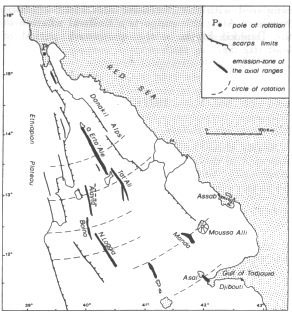
| From north to south they are : Erta Ale, Tat'Ali and Alayta, Dabbahu, Manda-Hararo and Manda- Inakir ranges. Volcanoes surrounding the Gulf of Zula and Alid although located in axial position, and showing some petrological analogy with the axial ranges, they are so close to the continental scarp as to allow, the crystalline basement to outcrop under the Alid volcano. The most characteristic is certainly the Erta'Ale range, where the picture is at the same time clear, simple and complete. |
Erta'Ale range
This range extends from the salt plain to Lake Afrera over a lengh of 80 km and covers a surface of about 2350 km2. Seven main volcanic centres are aligned on the NNW-SSE direction, showing different stages of volcanological-petrological evolution. The volcanological evolution starts at the fissural stage (as examplified by the region South Hayli Gub) and through the shield volcano stage (Erta Ale volcano) ends with stratovolcan (Ale Bagu, Dallafilla) and cumulovolcanoes (Borale Ale). The earliest activity is frequently subaqueous, and numerous hyaloclastite rings and subaqueous flows can be observed within and around the Erta' Ale range. Fissural emissions have always given picritic basalts and basalts, while shield volcanoes are mainly built by intermediate rocks types and strato and cumulovolcanoes by trachytes, rhyolites and peralkaline rhyolites. This range is very recent, and all the volcanoes are still active (hot springs, fumaroles, solfatares, molten lava flows), the most spectacular being Erta'Ale, with an almost permanent lava lake activity for at least 130 years.
Erta Ale volcano
Erta Ale is in many ways an exceptional volcano. It is among the three volcanoes in the world that has had a long duration active lava lake, probably since at least 1873. Erta Ale, also is part of a chain of active volcanoes located in the center of one of the six Afar rifts where an open ocean has formed in connection with a hot spot (inner Earth volcanism). Erta Ale is a very isolated basaltic shield volcano and most active volcano in Ethiopia. The broad, 50-kilometer-wide volcano rises more than 600 meters from below sea level in the barren Danakil depression. Erta Ale is the namesake and most prominent feature of the Erta Ale Range. It has a 0.7 x 1.6 kilometers, elliptical summit crater housing steep-sided pit craters. Another larger 1.8 x 3.1 kilometer-wide depression elongated parallel to the trend of the Erta Ale range is located to the southeast of the summit and is bounded by curvilinear fault scarps on the southeast side. Fresh-looking basaltic lava flows from these fissures have poured into the caldera and locally overflowed its rim.
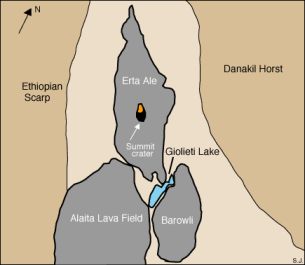
| The summit caldera is renowned for one, or sometimes two long term lava lakes that have been active since at least 1967, or possibly since 1906. Recent fissure eruptions have occurred on the northern flank of Erta Ale. Given its age, scientists think the lake must have a continuous link to a shallow magma chamber, which is itself fed on a regular basis by magma uplifts more directly connected to the formation of the rift |
Lava lake activity
The activity of the lava lake is characterized by several points of gas discharge that release bubbles and by what appears to be rather stable convection. The spots where the lava uplifts correspond to the location of gas release. The study of convection in the lava lake (the number of conduits or rising feeding currents, the depth at which bubbles appear, etc.) is a key parameter in the dynamics of lava lakes. (photo lava lake in 2002)
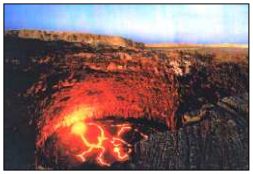
Recent field investigations and measurements ( Allard and al., March 2003) showed that the SO2 emission rates from the volcano averaged 0.7 kg s-1 from the active lava lake and 1.3 kg s-1 (about 110 tons day) from the whole volcano, including fumarolic emissions in the north part of the caldera. The average S/Cl (2.9) and S/F (52) ratios in plume from the lava lake imply a daily outpout of 19 tons d-1 of HCl and 1 ton d -1 de HF. The SO2 outpout combined with an estimate of the sulfur content of the melt indicates a magma supply rate of order 650 kg s-1 (~0.25 m3 s-1) at this time, equivalent to the magma production rate of a ~22 km long section of mid-ocean ridge. Radiant heat power from the lava lake, measured by infrared thermography, was found to vary between about 5 and 30 Mw according to activity of the lake surface and time elapsed since resurfacing events.
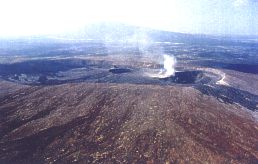
|
Aerial view of the Erta Ale caldera |
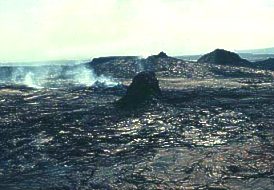
|
View from the summit caldera of the Erta Ale |
First SVE fieldwork - December 2004
A first visit of the SVE-SVG group (4th of December 2004) have permits to observe an important change in the activity of the volcano. The lava lake activity stopped within the South pit crater and a solidified lava crust has filled the whole part of the crater floor (about 15 m below the crater rim). Three (4) coalescent hornitos (about ten meters high) have built on the solidified lava crust in the SE part of the South crater. During the night between 4th of 5th of December, some incandescent degassing lava was visible at the summit of two hornitos. Moreover, we have also noted that a new activity has recently occured within the North crater. A solidified lava bulge uplifted and filled more than 4/5 of the crater floor (about 20-25 below the crater rim). Strong and noisy degassing activity was occcuring in the central part of the lava bulge from several small hornitos. From the smell and bluish color, these gases contained a high quantity of SO2. During the night , ten small incandescent vents were visible at the periphery of the lava bulge. In the morning, two plumes rose above the volcano
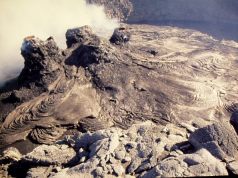
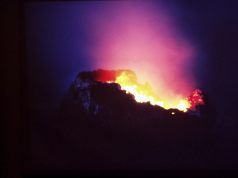
South crater hornitos in December 2004 (H.Gaudru)
Second SVE fieldwork - January 2005
An international team led by SVE carried out a new visit at the Erta Ale from 22nd of January to 23rd of January 2005. During these two full days at the summit the eruptive activity showed no significant change since our previous observation carried out in Deember 2004. Degassing activity was still occuring from 3 of the 4 coalescents hornitos located in the SW part of the South crater, but decreased slightly in comparison with our December observations. There were about 10 m high and represented the only portion of the lava crust covering the crater floor where gas emissions were in evidence. One of the hornitos contained glowing molten lava visible from a window located in the upper part. During the clear day of Sunday 23rd of January, members of the team abseiled down within the crater to collect recent lava poured out from the hornitos during partial collapse. Degassing activity (mainly SO2) from the North crater has also slightly decreased in comparison with early December 2004. From a small terrace located in the NW part of the crater it was possible to observe the degassing activity from several hornitos ( some of them were several meters high in the central part of the " lava bulge ") - Near the NW wall of the crater two small red glowing areas were visible at the summit of two other hornitos. Seismic activity of the volcano, together with infrasound signals were recorded by a portable system of the University of Hamburg. Preliminary results of this deployment will be reported soon at this place.
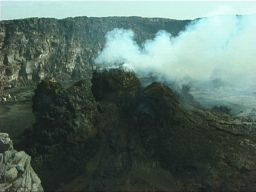
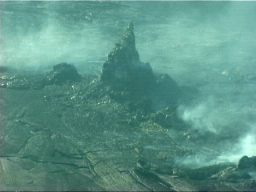
Hornitos activity in the South crater (January) H.Gaudru
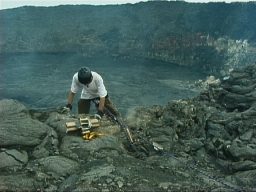
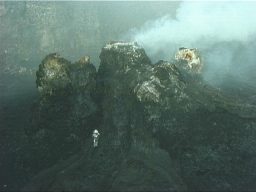
A member of the team abseiled down within the South crater